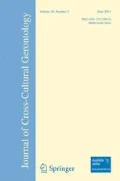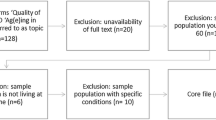Abstract
A 5-year cohort study was conducted to determine factors that predict the institutionalization of elderly people who reside at home in a geographically-defined rural community in southern Japan. Among 766 (321 men and 445 women) residents living at home, 742 (97%) were followed-up for 5 years. During that period, 55 (25 men and 30 women) subjects were institutionalized. In univariate analysis, institutionalization of men was significantly associated with incontinence (either urinary or fecal), speech impairment, impairment in activities of daily living (ADLs: transferring, eating, dressing, bathing), being housebound, and the use of a commode. In women, it was associated with incontinence, visual impairment, ADLs impairment, being housebound, and the use of a commode. Using Cox regression hazard model analysis, incontinence was identified as a predictor for institutionalization in men, but not in women. In women, visual impairment was a predictor for institutionalization. The use of a commode and the other variables had no association with institutionalization in either sex. In conclusion, incontinence is a predictor for institutionalization in elderly men. Use of a commode, however, does not appear to have a preventive effect with respect to institutionalization in elderly men.

Similar content being viewed by others
References
Abrams, P., Cardozo, L., Fall, M., Griffiths, D., Rosier, P., Ulmsten, U. et al. (2002). The standardization of terminology of lower urinary tract infection: report from the standardization sub-committee of the International Continence Society. Neurourology and Urodynamics, 21, 167–178.
Aguero, T. H., von Strauss, E., Viitanen, M., Winblad, B. & Fratiglioni, L. (2001). Institutionalization in the elderly: the role of chronic diseases and dementia: cross-sectional and longitudinal data from a population-based study. Journal of Clinical Epidemiology, 54, 795–801.
Brodaty, H., McGilchrist, C., Harris, L., & Peters, K. E. (1993). Time until institutionalization and death in patients with dementia: role of caregiver training and risk factors. Archives of Neurology, 50, 643–650.
Chassagne, P., Jego, A., Gloc, P., Czernichow, P., Bouaniche, M., Doucet et al. (2000). Does treatment of constipation improve faecal incontinence in institutionalized elderly patients? Age and Ageing, 29, 159–164.
Colerick, E. J., & George, L. K. (1986). Predictors of institutionalization among caregivers of patients with Alzheimer’s disease. Journal of the American Geriatrics Society, 34, 493–498.
Fisher, L., & Lieberman, M. A. (1999). A longitudinal study of predictors of nursing home placement for patients with dementia: the contribution of family characteristics. Gerontologist, 39, 677–686.
Guralnik, J. M., Simonsick, E. M., Ferrucci, L., Glynn, R. J., Berkman, L. F., Blazer, D. G. et al. (1994). A short physical performance battery assessing lower extremity function: association with self-reported disability and prediction of mortality and nursing home admission. Journal of Gerontology, 49, 85–94.
Hebert, R., Dubois, M. F., Wolfson, C., Chambers, L., & Cohen, C. (2001). Factors associated with long-term institutionalization of older people with dementia: data from the Canadian study of health and aging. Journal of Gerontology, 56, M693–M699.
Hirvensalo, M., Rantanen, T., & Heikkinen, E. (2000). Mobility difficulties and physical activity as predictors of mortality and loss of independence in the community-living older population. Journal of the American Geriatrics Society, 48, 493–498.
Holroyd-Leduc, J. M., Mehta, K. M., & Covinsky, K. E. (2003) Urinary incontinence and its association with functional decline, nursing home admission, and mortality. Journal of the American Geriatrics Society, 51, S56–S57.
Inoue, K., & Matsumoto, M. (2001). Homebound status in a community-dwelling elderly population in Japan. Asia-Pacific Journal of Public Health, 13, 109–115.
Katz, S., Ford, A. B., Moskowitz, R. W., Jackson, B. A., & Jaffe, M. W. (1963). Studies of illness in the aged. Journal of the American Medical Association, 185(12), 914–919.
Landi, F., Cesari, M., Russo, A., Onder, G., Lattanzio, F., & Bernabei, R. (2003). Potentially reversible risk factors and urinary incontinence in frail older people living in community. Age and Ageing, 32, 194–199.
Lawton, M. P., & Brody, E. M. (1969). Assessment of older people: self-maintaining and instructive activities of daily living. Gerontologist, 9, 179–186.
Lim, P. P. J., Sahadeva.n, S., Choo G. K., & Anthony, P. (1999). Burden of caregiving in mild to moderate dementia: an Asian experience. International Psychogeriatrics, 11, 411–420.
Lipsitz, L. A., Nakajima, I., Gagnon, M., Hirayama, T., Connelly, C. M., Izumo, H. et al. (1994). Muscle strength and fall rates among residents of Japanese and American nursing homes: an international cross-cultural study. Journal of the American Geriatrics Society, 42, 953–959.
Mahoney, F. I., & Barthel, D. W. (1965). Functional evaluation—the Barthel index. Maryland State Medical Journal, 14, 914–919.
McFaul, S., & Miller, B. H. (1992). Caregiver burden and nursing home admission of frail elderly persons. Journal of Gerontology, 47, S73–S79.
Nakanishi, N., Tatara, K., Naramura, H., Fujiwara, H., Takashima, Y., & Fukuda, H. (1997). Urinary and fecal incontinence in a community-residing older population in Japan. Journal of the American Geriatrics Society, 45, 215–219.
Naylor, J. R., & Mulley, G. P. (1993). Commodes: inconvenient conveniences. British Medical Journal, 307, 1258–1260.
Nuotio, M., Tammela, T. L. J., Luukkaala, T., & Jylha, M. (2003a). Predictors of institutionalization in an older population during a 13-year period: the effect of urge incontinence. Journal of Gerontology, 58, M756–M762.
Nuotio, M., Jylha, M., Luukkaala, T., & Tammela, T. L. (2003b). Urinary incontinence in a Finnish population aged 70 and over: prevalence of types, associated factors and self-reported treatments. Scandinavian Journal of Primary Health Care, 21, 182–187.
Resnick, N. M., Yalla, S. V., & Laurino, E. (1989). The pathophysiology of urinary incontinence among institutionalized elderly persons. New England Journal of Medicine, 320, 1–7.
Resnick, N. M., & Griffiths, D. J. P. (2003). Expanding treatment options for stress urinary incontinence in women. Journal of the American Medical Association, 290, 395–397.
Sahadevan, S., Lim, P. P. J., & Choo, P. W. J. (1999). Dementia in the hospitalized elderly: a study of one hundred consecutive cases in Singapore. International Journal of Geriatric Psychiatry, 14, 261–265.
Steinbach, U. (1992). Social networks, institutionalization, and mortality among elderly people in the United States. Journal of Gerontology, 47, S183–S190.
Thom, D. H., Haan, M. N., & Van Den Eeden, S. K. (1997). Medically recognized urinary incontinence and risks of hospitalization, nursing home admission and mortality. Age and Ageing, 26, 367–374.
Thomas, P., Ingrand, P., Lalloue, F., Hazif-Thomas, C., Billon, R., Vieban, F. et al. (2004). Reasons of informal caregivers for institutionalizing dementia patients previously living at home: the Pixel study. International Journal of Geriatric Psychiatry, 19, 127–135.
Torti, F. M., Gwyther, L. P., Reed, S. D., Friedman, J. Y., & Schulman, K. A. (2004). A multinational review of recent trends and reports in dementia caregiver burden. Alzheimer Disease and Associated Disorders, 18, 99–109.
Tsuji, I., Whalen, S., Finucane, T. E. (1995). Predictors of nursing home placement in community-based long-term care. Journal of the American Geriatrics Society, 43, 761–766.
Umegaki, H., Ando, F., Shimokata, H., Yamamoto, S., Nakamura, A., Endo, H. et al. (2003). Factors associated with long hospital stay in geriatric wards in Japan. Geriatrics and Gerontology International, 3, 120–127.
Victoroff, J., Mack, W. J., & Nielson, K. A. (1998). Psychiatric complications of dementia: impact on caregivers. Dementia and Geriatric Cognitive Disorders, 9, 50–55.
West, S. K., Munoz, B., Rubin, G. S., Schein, O. D., Bandeen, R. K., Zeger, S. et al. (1997). Function and visual impairment in a population-based study of older adults: the SEE project. Salisbury Eye Evaluation. Investigative Ophthalmology and Visual Science, 38, 72–82.
Author information
Authors and Affiliations
Corresponding author
Rights and permissions
About this article
Cite this article
Matsumoto, M., Inoue, K. Predictors of Institutionalization in Elderly People Living at Home: The Impact of Incontinence and Commode Use in Rural Japan. J Cross Cult Gerontol 22, 421–432 (2007). https://doi.org/10.1007/s10823-007-9046-2
Received:
Accepted:
Published:
Issue Date:
DOI: https://doi.org/10.1007/s10823-007-9046-2




